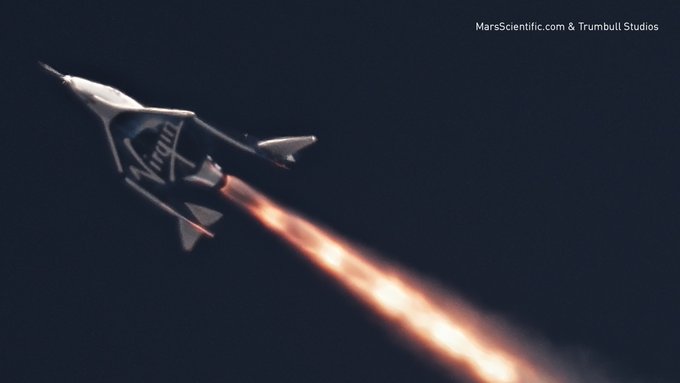Richard Branson’s fledgling space tourism company Virgin Galactic performed a powered flight of its spacecraft today, the first since a fatal crash in 2014.
Virgin’s spacecraft is unlike others because it is launched mid-flight by a larger plane called White Knight Two. This particular version of the spacecraft, dubbed SpaceShipTwo VSS Unity, has performed seven glide tests since it was built in 2016. Like those previous tests, it was carried high above the Mojave Desert by White Knight Two and released at 46,000 feet. But today, pilots Mark Stucky and Dave Mackay fired Unity’s engine and continued skyward.
The spaceplane’s engine burned for 30 seconds, pushing the Unity supersonic to Mach 1.87 before the engines cut off. It coasted to 84,000 feet before gliding down again for a safe landing at the company’s spaceport back in Mojave. White Knight Two safely touched down roughly 30 minutes later.
The trouble that led to Virgin Galactic’s 2014 crash had to do with the craft’s tail wings. The wings on SpaceShipTwo are adjustable so that pilots can perform a maneuver that’s known as “feathering,” which helps slow the plane as it reaches the peak of its parabolic flight path. During that last powered flight copilot Michael Alsbury unlocked the tail wings early while SpaceShipTwo was still accelerating. This resulted in forces of over 9Gs, which tore the plane apart, according to a subsequent NTSB investigation. Alsbury died in the crash, and pilot Peter Siebold was severely injured.
Virgin Galactic stayed grounded for just over two years after that routine test flight went wrong. In the meantime, the company built a new version of SpaceShipTwo from the ground up with better safety controls for the tail wing’s locking mechanism. The previous SpaceShipTwo had been built by a company called Scaled Composites, which devised this air-launching system for the 2004 Ansari X Prize competition. The version of the plane that flew then, called SpaceShipOne, holds the distinction for being the first vehicle used for crewed private spaceflight.
Virgin Galactic has been busy since returning to the air in late 2016 for the first of those glide flights. It created a spinoff company for launching satellites early last year, and in October, Virgin received a $1 billion investment from Saudi Arabia.
Today’s powered test of Unity puts Virgin Galactic back in the position to ramp up development on the way toward meeting Branson’s ultimate goal of shuttling paying tourists on short runs up into space. When that could happen is still a source of debate. Branson has said as recently as October that he believes his own first flight on SpaceShipTwo could come sometime in mid-2018. But much like his billionaire space company CEO counterpart Elon Musk, Branson is known for ambitious timelines

